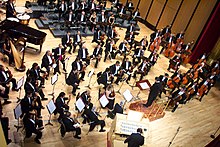Orchestra
Appearance

An orchestra is a large instrumental ensemble typical of classical music, which mixes instruments from different families, including bowed string instruments such as violin, viola, cello and double bass, as well as brass, woodwinds, and percussion instruments, each grouped in sections.
Quotes
[edit]- Numerous important conductors and composers were (and are) players of instruments other than the piano or organ over the course of their careers (Hans Richter, Edric Cundell, Daniel Jones, Edward Downes, Cedric Thorpe Davie and Norman Del Mar were hornists, Malcolm Arnold and Elgar Howarth trumpeters, Gustav Holst and George Alexander Macfarren trombonists, Simon Rattle a percussionist, Christian Darnton a bassoonist, Arthur Nikisch, Basil Cameron, Eugène Goossens and George Lloyd violinists, John Barbirolli, Charles Lucas, Havergal Brian and Arturo Toscanini cellists, and Benjamin Britten and Frank Bridge were violists). The intimate knowledge of the orchestra one gleans as a player is very valuable for conducting a symphony orchestra or writing orchestral compositions.
- Jürgen Schaarwächter (27 February 2015). Two Centuries of British Symphonism: From the beginnings to 1945. A preliminary survey. With a foreword by Lewis Foreman. Volume 1. Georg Olms Verlag. p. 584. ISBN 978-3-487-15227-1.
- "Contrary to popular belief, violas are more important than you think," - C.M., an orchestra teacher
- Jürgen Schaarwächter (27 February 2015). Two Centuries of British Symphonism: From the beginnings to 1945. A preliminary survey. With a foreword by Lewis Foreman. Volume 1. Georg Olms Verlag. p. 584. ISBN 978-3-487-15227-1.

